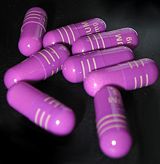Pharmaceutical Drugs
From Proteopedia
| Line 118: | Line 118: | ||
</tr> | </tr> | ||
</table> | </table> | ||
| + | <br/> | ||
===References=== | ===References=== | ||
Revision as of 15:57, 11 December 2010
The Pharmaceutical industry is one of the world’s largest industries, grossing well over $300 billion in the United States alone. Understanding how the drugs the pharma industry develops work and different characteristics of these compounds is important to nearly everyone as 50% of the US population takes at least one prescription medication regularly and nearly everyone takes a pharmaceutical pill at some point in their life.[1] The following is a growing list of pharmaceutical compounds organized by disorder.
See Pharmaceutical Drug Targets for a list of drug targets organized by disease.
Treatments
The following is a list of pharmaceutical treatments for various diseases, organized by disorder. Each entry highlights general information about the therapeutic, pharmacokinetic data comparisons within its drug class, and a structural analysis explaining how the drug compound functions in vivo.
Alzheimer's Disease |
Bacterial Infection |
Cancer |
|||
|
|
|
|||
Diabetes |
Erectile Dysfunction |
Hypercholesterolemia |
|||
|
|
||||
Hypertension |
HIV |
Inflammation & Arthritis |
|||
|
|
|
|||
Influenza |
-- |
-- |
|||
|
|
|
References
- ↑ http://www.npr.org/blogs/health/2010/09/03/129626052/a-portrait-of-health-prescription-drugs-in-america
Proteopedia Page Contributors and Editors (what is this?)
David Canner, Alexander Berchansky, Michal Harel, Karsten Theis, Wayne Decatur

